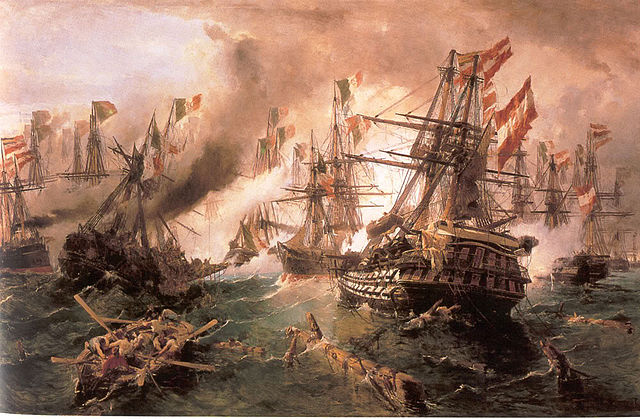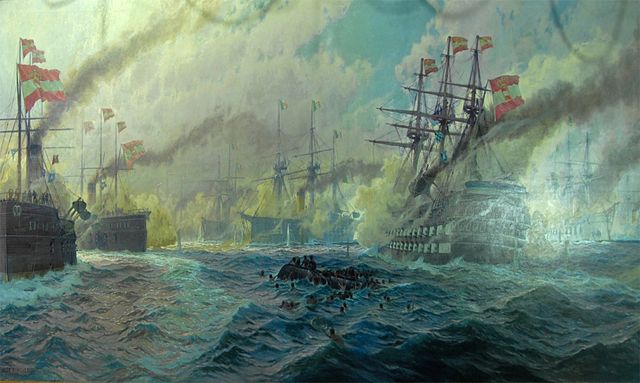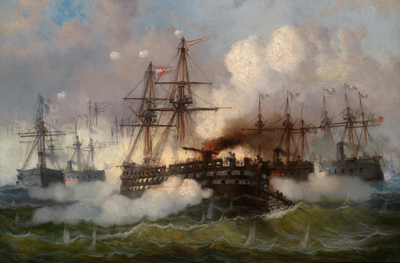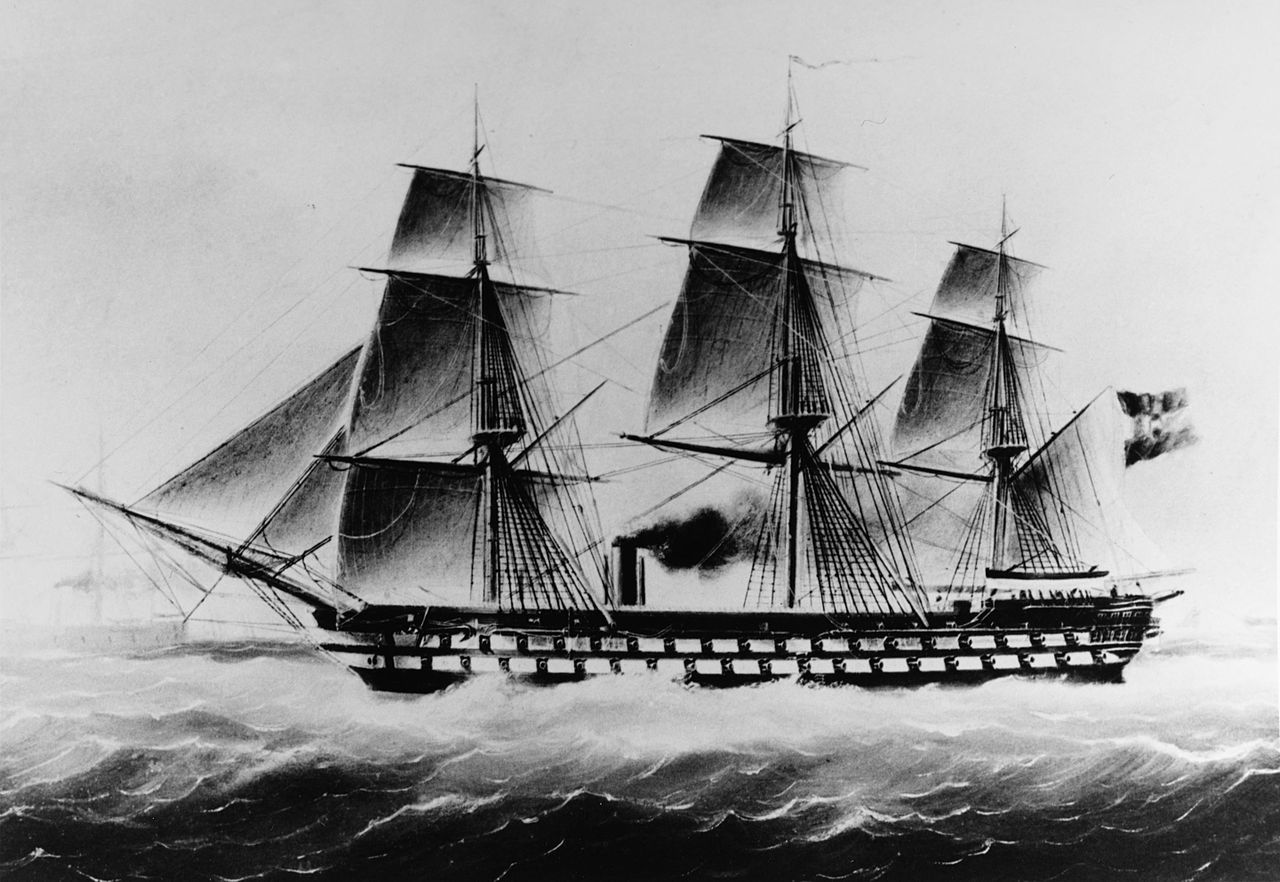SMS Kaiser, Austria’s “wooden battleship”.
First article for the 1860 section, the Austrian Navy’s legendary SMS Kaiser: Born as a formidable 2-decker ship of the line, arguably the pride of the Austrian Navy in 1860, she became immortal during the battle of Lissa, being the only sailing ship of the line in history to engage ironclads. She was completely rebuilt as an central battery ironclad in 1873, rebuilt again in 1882, ending her very long career as a barrack ship in WWI.

SMS Kaiser at Lissa, 1866, a legend is born;
By the early 1850s, the Austrian Empire had to face a threatening Kingdom of Sardinia—which which suceeded in unifying most of the Italian peninsula within ten year. It also started to modernize its navy with new steam warships. Archduke Ferdinand Maximilian then ordered a serie of steamships of its own, the first of which was the screw frigate SMS Radetzky in Great Britain, ordered and laid down in 1852. In 1854, Ferdinand Maximilian decided to order a large steamship of the line, as France and Great Britain had, and to gain time, proposed to base it on the British 91-gun HMS Agamemnon. Her plans was provided by the Royal Navy to Austria, in exchange for neutrality during the Crimean War. This war soon showed the performances of the French Napoleon and Algésiras, which prompted the Austrians to have their Agamemnon design incorporating its features. It was made larger and incorporated a much better and larger machinery. A sister-ship, slightly larger 101 guns named “SMS Österreich”, was ordered, then cancelled in 1859 and never laid down.
The Kaiser according to Wilhelm von Rüstow measured 74 meters (242 ft) long and displaced 5,337 long tons (5,423 t) while Andrew Lambert saw her 74.02 metres (242 ft 10 in) long for on 5,194 long tons. Conway’s figures after conversion as a modern ironclad, cetral battery ship in 1871 states 5,720 tons for 77.75 meters at the waterline but her ram must be taken in account. The new displacement included all the weight of the armour, reaching 6 inches, so the original displacement was probably closer to von Rüstow’s figures.

Her beam was however of 16.21 metres (53 ft 2 in) and crew comprised about 900 officers and men, including a small naval infantry coningent for landing parties. Her main battery comprised ninety-two cannons, of various calibers to avoid stability issues as customary of the time: She had sixteen 60-pounder guns at the lower battery deck, close to the waterline, completed by seventy-four 30-pounder smoothbores partly on the upper deck and two 24-pounder breech loaders at the front on the upper deck. She was powered by a Maudslay, Sons and Field two-cylinder horizontal steam engine driving a single screw propeller 5.75 m (18.9 ft) in diameter. Steam came from six coal-fired boilers and twenty-six fireboxes, rated at 800 nominal horsepower. Of course her rigging included a three-mast configuration and large enough sail area to complement her top speed and replace the engine in some occasions. In 1855 indeed, confidence in steam engines was growing but not to the point of dropping sail entirely. This slow transition went on until the early 1890s. SMS Kaiser was laid down on 25 March 1855 in Pola and launched on 4 October 1858.

SMS Kaiser after the battle of Lissa, showing her formast and funnel gone, as well as her hole bow, crushed in her ramming of Re d’Italia she was never designed for.
Second life as an Ironclad (1873-93)

Author’s illustration of SMS Kaiser after conversion as an ironclad, 1873.
Later in her career, Chronic budgetary problems plagued the Austro-Hungarian Empire, admiral Tegetthoff failing to secure funds for new ships. In 1868, a new building program was proposed, rejected by the government. The Parliament however was more generous and at least allocated funds to modernized modernize SMS Kaiser, by then completely obsolete. On 2 February 1869 she was sent into a drydock for her hull to be examined by a commission. She was found to be in good general condition so the project of modernizing her get an approval.
1873 specifications |
|
| Dimensions | Lenght 75.87 m oa (249ft), Beam 15.25 m (50 ft), Draft 6.15 m (20 ft 2 in) |
| Displacement | 3,548 long tons standard |
| Crew | 400 |
| Propulsion | 1 screw, Two 2-cyl. H LP engines, 8? boilers, 2,755 ihp |
| Speed | 13.28 knots () |
| Armament | 8x 21cm L/20 Krupp BL, 4× 9cm L.24 Uchatius BL, 2x 7cm L/15 Krupp field guns, 6x 4.7cm L/33 QF, 3x 4.7mm Hotchkiss revolver, 2x 25 mm Nordenfelt MGs, 4x 35cm TTs (1 bow, 1 ster, 2 beam) |
| Armor | Belt armor: 200 mm, Bulkheads: 115 mm, Casemate 125mm. |
1873 Refit
The plan was to convert her as an ironclad casemate ship, the latest type possible. The old wooden planking below the waterline was entirely replaced and above water, iron was used all around. Her bow notably was cmpletely recast as an iron ram bow and the stern was modified as well, but still including a traditional gallery. Her length went to 77.75 m (255.1 ft) at the waterline, her beam to 17.76 m (58.3 ft) but her draft remained relatively similar at 7.37 m (24.2 ft) with a superior displacement of 5,720 long tons (5,810 t). The machinery was also reviewed with Superheaters installed to boost heroriginal boilers and the steam engine modernized and rerated to reach 13 knots (24 km/h; 15 mph). Total output was 3,130 ihp (2,330 kW), but with the boiler red hot. In service it was reduced to a more reasonable 11.55 knots (21.39 km/h; 13.29 mph), obtained from 2,786 ihp (2,078 kW). At 10 knots, she still could cover 1,519 nautical miles (2,813 km; 1,748 mi).
Armament-wise, In addition to her eight central battery Krupp breech-loading main guns, 21 cm (8.26 in), she was rearmed with four 9 in (230 mm) 23-pounder muzzle-loading guns (Uchatius), also breech-loaders, placed on railings to increase their traverse. They were all grouped together in a central two-story casemate. The secondary battery in portholes comprised 8-pounder Rifled Muzzle Loaders. Armour-wide, she obtained an armored belt at the waterline while the central citadel protecting machinery spaces was protected by 152 mm (6 in) thick plating. On both ends, the belt was reduced to 102 mm (4 in). The casemate itself was further protected by 127 mm (5 in). There were two rows of armour plates, all other came from old discarded armoured frigates.
SMS Kaiser was eventually re-launched in 1871, so after a year and a half conversion, but again, her completion was plagued by budgetary issues and the armor plate or iron fittings purchased from Britain were not paid, delaying her completion. She was only completed in December 1873, so a good year behind schedule. Sea trials started on 21 December but she was already obsolescent as turret ships became the new norm. The Italians notably just laid down the two steam-only all iron and steel Duilio-class ironclads, armed with the most powerful guns in the Mediterranean, 450 mm (17.7 in) artillery pieces.
1882 refit

Her modernization was in fact gradual. In 1876, she received a 7.62 m (25 ft) propeller, now able to reach 12.72 knots. In 1880, her rigging was completely reduced (still she had three masts). Her decks were cutout ut n drydoc to access and removed her very old boilets; She received modern ones, improving her output greatly, however her new top speed it not known. More importantly during this major refit in 1880-82 she receoved the following armament:
- Six 9 cm (3.5 in) 24-caliber (cal.) breech-loading guns
- Two 7 cm (2.8 in) 15-cal. guns
- Four 47 mm (1.9 in) 33-cal. quick-firing guns
- Three 47 mm Hotchkiss revolver cannon
- Four 25 mm (0.98 in) machine guns
- (From 1885) Three 35 cm (14 in) torpedo tubes, one bow, two broadsides.

Auctioned Postcards of SMS Bellona (former Kaiser) as barrack ship in Pola in 1909 (sold by Darabanth)).
Resources & links
On agenziabozzo.it
ilportaledelsud.org
naviearmatori.net
International naval journal 2015
armedconflicts.com
Model kit scratchbuilt
SMS Kaiser in service

SMS Kaiser rammming Re di Portogallo at Lissa, 1866 (Painting by Eduard_Nezbeda)
SMS Kaiser was commissioned into the Austrian Navy in 1859. Her sea trials started on 6 December. She made her first commissioned voyage, from Muggia to Pola, under command of Captain Friedrich von Pöck. In February 1864, she joined the squadron sent to participate to the Second Schleswig War against Denmark, with Prussia. She sailed with the frigate SMS Juan de Austria and two others vessels under command of Vice Admiral Bernhard von Wüllerstorf-Urbair. There she met with the frigates SMS Schwarzenberg and Radetzky (Captain Wilhelm von Tegetthoff). They combined in Den Helder (Netherlands) before heading for Cuxhaven, reaching it on 30June. Both the relatvely small Prussian fleet and the Austro-Hungarians outnumbered the Danish fleet, which was condemned to remain in port until the end of the war. The Austro-Prussian squadron soon imposed a blockade and later provided cover when capturing the islands off the western Danish coast.
Battle of Lissa (1866)

Kaiser surrounded by Italian ironclads at Lissa, by Constantine Volanakis
In June 1866, Italy declared war on Austria (Third Italian War of Independence). It happened right during the Austro-Prussian War. Rear admiral Tegetthoff was given overall command of the fleet. He prepared it and trained the crew hard before heading in Ancona on 27 June. The idea was to draw out the Italians. However Admiral Carlo Pellion di Persano refused to make any move. SMS Kaiser became flagship of the 2nd Division, under command of Baron Anton von Petz. On 16 July, Persano at last was ordred to oust the Austrians from Ancona and sailed with the entire italian fleet, twelve ironclads, and headed for the island of Lissa. They arrived on 18 July, escorting troopships with 3,000 soldiers to occupy the island; The flee then proceeded to shell Austrian fortifications but its landing failed two days after. Tegetthoff was informed of the situation by telegrams on 17-19 July and at first believed it was a feint to draw him away from Pola and Venice. However on the 19 her realized Lissa was the real objective, requested permission to attack and obtained it.
Tegetthoff’s fleet arrived off Lissa on 20 July, catching Persano gearing for another landing attempt, split into three groups surrounding the island. Thus only the first was available to meet the Austrians. Tegetthoff meanwhile arranged his ironclads into a wedge-shaped formation, his wooden warships (2, 3rd Divisions) following behind. SMS Kaiser was the lead ship of the 2nd Division, the center of the line. Persano made the error of transferring from Re d’Italia to Affondatore, leaving a curcial gap in command, allowing Tegetthoff to split and divide the Italian fleet. In the “ramming fest” melee that followed, confusion soon emerged. Petz onboard SMS Kaiser went south to attack the Italian wooden fleet still out of action, but met instead the rear Italian ironclad line. The latter attacked Kaiser, and Petz reacted by reorienting his whole division to face the Italian ironclads, Kaiser leading the charge.

Kaiser in the Melee at Lissa, paintings by Kircher
Castelfidardo, Varese, and Principe di Carignano started a circle in order to ram Kaiser, while broadsiding her. The following long minutes saw both Austrian and Italian vessels trying to get into position to ram each other, recalling the antique galley battles. Persano in Affondatore spotted and tried to ram Kaiser but missed. Kaiser however suceeded to ramm the ironclad Re di Portogallo to protect the Erzherzog Friedrich and Kaiserin Elizabeth of the 2nd division, less protected. It was not an esy decision to make as contrary to ironclads, the all-wooden Kaiser had no dedicated ram or metal prow. Petz only thought the energy of the move would severely harm the ironclad. It only struck a glancing blow and inflicted little damage in the end, while Re di Portogallo replied with its light guns. Kaiser saw a fire reupting while loosing many gunners. Eventually by reversing she was able to break free. Affondatore came bac for a second attempt but missed again. She did score hits however and badly damaging SMS Kaiser, loosing 20 more crewmen. Kaiser’s broadside however was devastating. She fired point-black on Affondatore’s deck, disabling all crew present, starting a fire, blewing holes into her. Kaiser’s riflemen in her fighting tops also scored many kills, in the Trafalgar tradition. A lucky shot from Kaiser struck one of Affondatore’s turrets. The concussion was enough to jam it. Kaiser in this fight lost her foremast while the funnel fell during the collision with Re di Portogallo. Petz eventually ordered to withdraw and limp back to Lissa.

Painting by Carl Berthold Püttner
The Austrian ironclads later disengaged from the melee, trying to protect their own wooden ships, after loosing Re d’Italia (rammed) and Palestro (badly burnt, exploded). Persano had its crew demoralized and eventually decided ot to give prchase and started to withdraw, followed by the Austrians until night fell. Both fleets then departed away for Ancona and Pola. On Kaiser, the quarremaster listed twenty-four killed and thirty-seven wounded, but the battle soon became the stuff of legend, immortalized by paintings. SMS Kaiser would remain the only ship of the line duelling with ironclad in naval history. She later became an ironclad herself.
Even if the battle of Lissa was over, the war was not, and after hasty repairs, Kaiser was maintained as flagship of her division, Tegetthoff keeping his fleet in the northern Adriatic, patrolling against a possible Italian attack which never came. On 12 August, Armistice was signed, and then the Treaty of Vienna. It was crushing for the Austrians depite their victories against the Italians at Lissa and Custoza, as they were decisively defeated by Prussia at Königgrätz. Austria eventually became Austria-Hungary (Ausgleich) in 1867 but was forced to cede Venice to Italy. Soon after this, the entire Austrian fleet was decommissioned and disarmed.
Later career 1873-1920
.jpg)
SMS Kaiser thetefore was mothballed in 1867, seeing no further service. In 1868, a new building program was rejected by the government but some funds were allocated to modernize her. On 2 February 1869 she entered the drydock to be examined by a commission and approval for conversion. She was entirely rebuilt as an ironclad casemate ship and recommissioned in the end of 1873. However she remained laid up from 1875 and spent the first four months of 1876 in the second Reserve. After an overhaul and and modifications she saw naval engineers trying to improve her rather abysmal performance by replacing her original propeller scraw in 1876. This very large, newlt cast propeller had a gargantuan diameter of 7.62 m (25 ft) !
speed tests on 7 December 1876 show her reaching 12.72 knots (23.56 km/h; 14.64 mph), the propeller helping for an extra knot. Back to the II Reserve she served as such until 1880, when her rigging was much reduced. She received new boilers as a complement to her new propeller. Her new secondary battery reduced to 9 cm (3.5 in) breech-loading guns and two 7 cm (2.8 in)/15 plus four 47 mm (1.9 in)/33 QF plus three Hotchkiss revolver, four machine guns. In 1885 she had three 35 cm (14 in) torpedo tubes added, bow and broadsides.
A commission examined again SMS kaiser in 1893. This time her old wooden hull behind was showing her age. The commission recommended she was “not suitable anymore for service”. The government negotiated for a resell to Venezuela in 1895 but this came to nil. In 1897 at least she was stricken and mothballed. She was completely disarmed in 1901. In 1902 her engines were removed. The freed space allowed her to be used as a barracks ship in Pola. She was formally stricken again, and for good, on 4 January 1902. By that time her name was changed to SMS Bellona and she became an utility hulk, still used however as barracks ship during WWI. Until 1917 she even hosted the staff of the II Reserve. In 1918 she hosted the naval training school staff, in addition to the II reserve HQ. After the war she seized by her old nemesis Italy (as war prize) but her fate is completely unknown from that point. It is assumed she was BU in 1920-21.



 Latest Facebook Entry -
Latest Facebook Entry -  X(Tweeter) Naval Encyclopedia's deck archive
X(Tweeter) Naval Encyclopedia's deck archive Instagram (@navalencyc)
Instagram (@navalencyc)





 Austrian Navy
Austrian Navy French Navy
French Navy Royal Navy
Royal Navy Armada Espanola
Armada Espanola K.u.K. Kriegsmarine
K.u.K. Kriegsmarine Dansk Marine
Dansk Marine Nautiko Hellenon
Nautiko Hellenon Koninklije Marine 1870
Koninklije Marine 1870 Marinha do Brasil
Marinha do Brasil Osmanlı Donanması
Osmanlı Donanması Marina Do Peru
Marina Do Peru Marinha do Portugal
Marinha do Portugal Regia Marina 1870
Regia Marina 1870 Nihhon Kaigun 1870
Nihhon Kaigun 1870 Preußische Marine 1870
Preußische Marine 1870 Russkiy Flot 1870
Russkiy Flot 1870 Svenska marinen
Svenska marinen Søværnet
Søværnet Union Navy
Union Navy Confederate Navy
Confederate Navy Armada de Argentina
Armada de Argentina Imperial Chinese Navy
Imperial Chinese Navy Marinha do Portugal
Marinha do Portugal Mexico
Mexico Kaiserliche Marine
Kaiserliche Marine 1898 US Navy
1898 US Navy Russkiy Flot
Russkiy Flot French Naval Aviation
French Naval Aviation Russian Naval Aviation
Russian Naval Aviation Sovietskiy Flot
Sovietskiy Flot Royal Canadian Navy
Royal Canadian Navy Royal Australian Navy
Royal Australian Navy RNZN Fleet
RNZN Fleet Chinese Navy 1937
Chinese Navy 1937 Kriegsmarine
Kriegsmarine Chilean Navy
Chilean Navy Danish Navy
Danish Navy Finnish Navy
Finnish Navy Hellenic Navy
Hellenic Navy Polish Navy
Polish Navy Romanian Navy
Romanian Navy Turkish Navy
Turkish Navy Royal Yugoslav Navy
Royal Yugoslav Navy Royal Thai Navy
Royal Thai Navy Minor Navies
Minor Navies Albania
Albania Austria
Austria Belgium
Belgium Columbia
Columbia Costa Rica
Costa Rica Cuba
Cuba Czechoslovakia
Czechoslovakia Dominican Republic
Dominican Republic Haiti
Haiti Hungary
Hungary Honduras
Honduras Estonia
Estonia Iceland
Iceland Eire
Eire Equador
Equador Iran
Iran Iraq
Iraq Latvia
Latvia Liberia
Liberia Lithuania
Lithuania Mandchukuo
Mandchukuo Morocco
Morocco Nicaragua
Nicaragua Persia
Persia San Salvador
San Salvador Sarawak
Sarawak Uruguay
Uruguay Venezuela
Venezuela Zanzibar
Zanzibar Warsaw Pact Navies
Warsaw Pact Navies Bulgaria
Bulgaria Hungary
Hungary

 Bundesmarine
Bundesmarine Dutch Navy
Dutch Navy Hellenic Navy
Hellenic Navy Marina Militare
Marina Militare Taiwanese Navy
Taiwanese Navy Chinese Navy
Chinese Navy Indian Navy
Indian Navy Indonesian Navy
Indonesian Navy JMSDF
JMSDF North Korean Navy
North Korean Navy Philippines Navy
Philippines Navy ROKN
ROKN IDF Navy
IDF Navy Royal New Zealand Navy
Royal New Zealand Navy Egyptian Navy
Egyptian Navy South African Navy
South African Navy

































 RN
RN
 Marine Nationale
Marine Nationale
 Soviet Navy
Soviet Navy
 dbodesign
dbodesign
Hi
Do You have some blueprints of SMS Kaiser (1858)
regards
Ivan
Hi Ivan, i would like to !
Actually the second postcard depicts another ship. Have a closer look at number of masts, funnels, and design of the casemate. This is SMS Tegetthoff, in 1912 renamed into SMS Mars.
Thanks, seems obvious now, i removed it;